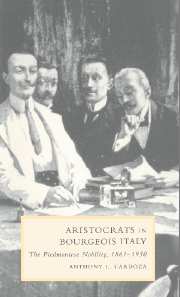Book contents
- Frontmatter
- Contents
- List of tables
- Acknowledgments
- Introduction
- 1 The making of the Piedmontese nobility: 1600–1848
- 2 The long goodbye: aristocrats in politics and public life: 1848–1914
- 3 Old money: the scale and structure of aristocratic wealth
- 4 Perpetuating an aristocratic social elite
- 5 The limits of fusion: aristocratic–bourgeois relations in nineteenth-century Piedmont
- 6 Retreat and adaptation in the twentieth century
- Bibliography
- Index
- CAMBRIDGE STUDIES IN ITALIAN HISTORY AND CULTURE
6 - Retreat and adaptation in the twentieth century
Published online by Cambridge University Press: 03 November 2009
- Frontmatter
- Contents
- List of tables
- Acknowledgments
- Introduction
- 1 The making of the Piedmontese nobility: 1600–1848
- 2 The long goodbye: aristocrats in politics and public life: 1848–1914
- 3 Old money: the scale and structure of aristocratic wealth
- 4 Perpetuating an aristocratic social elite
- 5 The limits of fusion: aristocratic–bourgeois relations in nineteenth-century Piedmont
- 6 Retreat and adaptation in the twentieth century
- Bibliography
- Index
- CAMBRIDGE STUDIES IN ITALIAN HISTORY AND CULTURE
Summary
As the preceding chapters have argued, the Piedmontese aristocracy proved to be more successful than their titled counterparts elsewhere on the Italian peninsula at maintaining a combination of landed wealth, social exclusivity, cultural traditions, and political influence in the second half of the nineteenth century. The same cannot be said for the following century. The extraordinary growth of industry in Piedmont, the rapid advance of mass politics, recurrent problems in the agricultural sector, demographic weakness, two wars, and ultimately the fall of the monarchy combined to transform irrevocably the identity, status and, material circumstances of the nobility in Piedmont by the middle of the twentieth century.
Old-line aristocratic families responded to these challenges in a variety of ways. Some conformed to popular stereotypes by squandering the remains of the ancestral patrimony on gambling, mistresses, and the high life or by retreating to their decaying country houses and palaces where they led a proud, but increasingly impoverished existence before simply dying off. For others, preeminence was followed not so much by decadence and disappearance as by adaption and survival. In fact, a number of titled families became active participants in a process of adjustment to the difficult circumstances that confronted them particularly after 1914. As a result, they remained an affluent and prominent component of Piedmontese high society in the decades that followed.
- Type
- Chapter
- Information
- Aristocrats in Bourgeois ItalyThe Piedmontese Nobility, 1861–1930, pp. 196 - 225Publisher: Cambridge University PressPrint publication year: 1998



